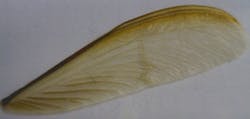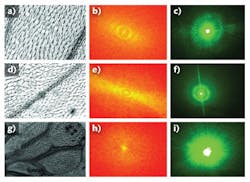Natural photonic micro- and nanostructures on insect wings and carapaces modify light through many different optical effects, ranging from diffraction, fluorescence, and antireflection to polarization and others. These biophotonic structures fall into two main groups: those that primarily reflect, and those that primarily transmit.
The effects of butterfly and beetle wings, which fall into the former group, are well-known; now, a group at the Indian Institute of Science Education and Research (IISER; Mohali, Punjab, India) has developed a simple, real-time, noninvasive, and nondamaging laser-based technique to examine the transmitting photonic structures found in flies, bees, and dragonflies (see figure). The technique includes a quantitative diffraction-based model that agrees well with experiment.CW or femtosecond pulsed light
In the technique, a collimated laser beam is passed through a wing that can be moved in x, y, and z; the resulting light pattern is captured by a digital camera and analyzed. The beam's millimeter-scale spot size is large enough to gather long-range symmetry info, but small enough to be scanned along a wing to see, for example, a rotation in the diffraction profile from one end of the wing to the other.
Interestingly, either continuous-wave (CW) or femtosecond pulsed lasers are used as the light source: the CW wavelength is either 532 or 632 nm (green or red), while the broad spectral band of the femtosecond laser falls in the 800 nm range.
Why is a femtosecond laser used as one of the light sources? Pramod Kumar, one of the researchers, explains that femtosecond lasers, while spatially coherent, produce light that bears a superficial resemblance to white light, highlighting the robustness of the diffraction pattern under broadband coherent IR light. The group wanted to study the coherent interaction of a short pulse with photonic structures at various nanometer- to micrometer-length scales.
"We want to probe the role of optical coherence and spatial correlation in the structural organization [of the wing] at long range as well as short range," says Kumar. "Insect wing surfaces have various symmetries in the microstructures' organization. The long-range order plays a crucial role in the development of the diffraction pattern in our case. Our laser beam spot size is about 2 to 3 mm, which is sufficient to cover a huge number of microstructures up to long range." In contrast, conventional high-magnification imaging techniques give precise local structural information but not long-range info, because of the very small (micrometer-scale) scan area being used at any one time.
"If one wants to scan whole wing surface to get the global information, then one has to do imaging thousands upon thousands of times," says Kumar. "Our technique is capable of giving the long-range structural organization information in a single shot. We have observed -90° to +90° rotation in the diffraction pattern, corresponding to the angular orientation of microstructures on a wing's surface. We have also measured the nanoscale friction and adhesion properties of the microstructures."2
Applications
In addition to use in insect studies, the technique can be used to size up potential optical uses of biophotonic structures. While the direct use of such structures in optical applications is limited because they are composed of biopolymers with rather poor mechanical, heat, and light stability, they provide intriguing templates for biomemetic applications, says Kumar.
"The zeroth-order diffraction pattern from an insect wing depends on the bandwidth of the incident light, which is an effect that could be used as a tool for measuring the autocorrelation width of an ultrashort laser pulse and also to characterize the coherence properties of individual pulses, which is very difficult to measure and is an important issue," he says.
In their newest research, the researchers are zeroing in on single-wing microstructures by using a Fourier-transform light-scattering technique to probe the scattering pattern from the microstructure. "A single microstructure works as a blazed grating, and its shape, size, and orientation play a crucial role for coherent interaction of light," says Kumar. "We have already seen the various rotations involved in the microstructures' organization on the whole wing surface, with rotated diffraction patterns revealing their signature. But now single microstructure scattering will be measured."
REFERENCES
1. P. Kumar et al., Laser Phys. Lett. (2015); doi:10.1088/1612-2011/12/2/025901.
2. A. Arora et al., Appl. Phys. Lett. (2014); http://dx.doi.org/10.1063/1.4865202.


